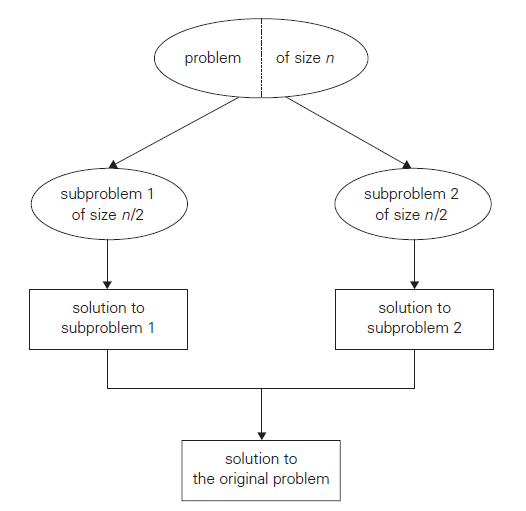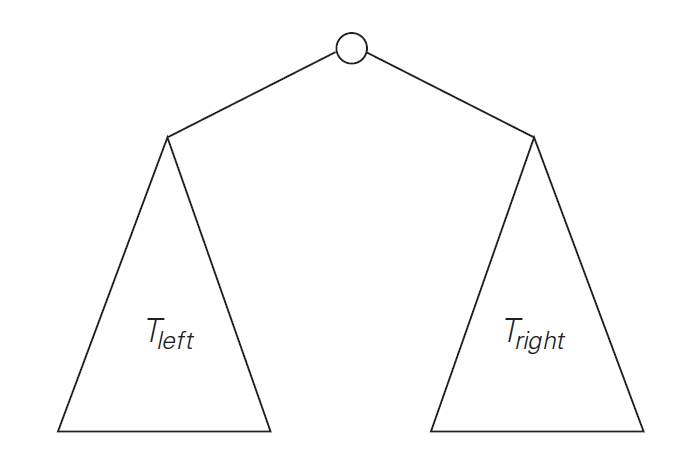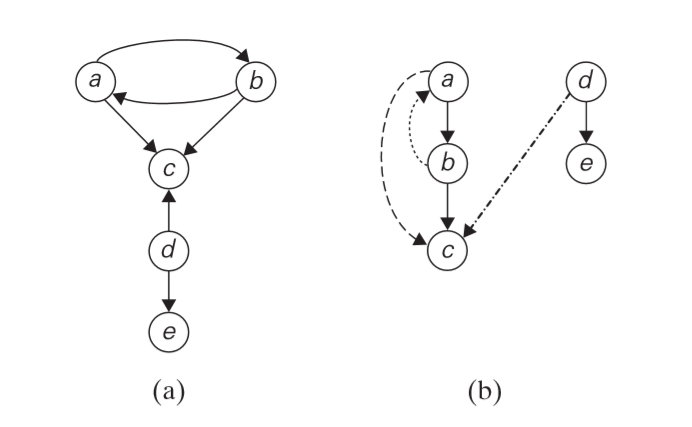Design of Algorithms
Divide and Conquer
Divide and Conquer
Table of Contents
- Overview
- General divide and conquer recurrence relation
- Binary Tree
- Tree traversals
- Closest Pair
- Topological Sorting
Overview
- divide and conquer:
- split into multiple smaller problems
- solve these: typically recursive, and may become brute force when sufficiently small
- combine sub-problem results to get final solution

- not necessarily more efficient than brute force
- some divide and conquer algorithms are the most efficient algorithms possible
- well suited to parallel computation, where each subproblem is solved simultaneously on a distinct processor
General divide and conquer recurrence relation
- problem size $n$ can be divided into $b$ sub-problems of size $n/b$, with $a$
sub-problems needing to be solved
- i.e. $a \ge 1, b > 1$, with $a, b$ constants
- with $n = b^k$ for some $k\in\Z^+$: time complexity $T(n)$
-
$f(n)$: time spent dividing into subproblems and combining subproblem solutions
-
applying the master theorem: if $f(n) \in \Theta(n), k > 0$:
Binary Tree

-
Binary tree T: finite set of nodes; a root + 2 disjoint binary trees $T_L$ (left) and $T_R$; otherwise empty
- all subtrees are also binary trees: many problems can be approached with divide and conquer/recursive algorithms
- not all questions about binary trees require traversal of entire tree
- e.g. search and insert requires processing one of two subtrees
Height
- height: length of longest path from root to leaf
"""
Recusively compute height of binary tree
input: binary tree T
output: height of T
"""
Height(T):
if T is empty:
return -1
else:
return max(Height(T_L), Height(T_R) + 1
- measure instance size by number of nodes $n(T)$
- number of comparisons for max height will be the same as number of additions $A(n(T))$, so for $n(T)>0$ with $A(0)=0$:
- checking the tree is empty is actually the most common operation here
- consider the tree drawn with internal nodes (circles) and empty children
as external nodes (rectangles)

- $\implies$ comparison to empty set occurs for all internal and external nodes, while addition is only for internal nodes
- for a full binary tree with $n$ internal nodes, every node except the root is 1 of 2 children
- total internal + external nodes is then: \(n+x = 2n+1\)
So
\[x = n+1\]Number of comparisons to empty tree $C(n)$ is then: \(C(n) = n+x = n + 1\) Number of additions $A(n)$ is: \(A(n) = n\)
Tree traversals
- most import divide and conquer algorithms for trees are tree traversals
- preorder traversal: root $\rightarrow$ left subtree $\rightarrow$ right subtree
- inorder traversal: left subtree $\rightarrow$ root $\rightarrow$ right subtree
- postorder traversal: left subtree $\rightarrow$ right subtree $\rightarrow$ root

- preorder: $a,b, d, g, e, c, f$
- inorder: $d, g, b, e, a, f, c$
-
postorder: $g, d, e, b, f, c, a$
- efficiency: identical to that of height, as recursive calls are made for each node of extended binary tree
Closest Pair
- brute force closest pair: $\Theta(n^2)$
- $P$: set of $n > 1$ distinct points in Cartesian plane, ordered by x-coordinate (non-decreasing)
-
$Q$: set of $n > 1$ distinct points in Cartesian plane, ordered by y-coordinate (non-decreasing)
- if $2\le n \le 3$: solve by brute force
- $n > 3$:
- divide points into 2 subsets $P_l, P_r$ of size $\lfloor n/2\rfloor$, analogous to vertical line through median x-coordinate
- solve recursively for $P_l, P_r$, to produce minimum distance $d_l, d_r$
- combine result: $d = \min{d_l, d_r}$
- now need to consider whether there are any pairs of points $p_l \in P_l, p_r \in P_r$ such that $dist(p_l, p_r) < d$; i.e. are there any points between $P_l, P_r$ closer than $d$ that we missed by splitting up the problem?
- only need to consider points from a strip of width $2d$ around the median, call these points $S$ obtained from $Q$
- scan S, looking for any points closer than $d_min$:
- for a point $p’(x’, y’) to be closer to $p(x, y)$ than $d_min$, the point must follow $p$
-
i.e. $ y-y’ <d_min$ - so $p’$ must be in a rectangle with width $2d$ and height $d_min$
- rectangle can only contain a few points as points in left and right rectangle must be at least $d$ distance apart
- can be shown that rectangle has $\le 8$ points (more rigorously $\le 6$)
- algorithm considers no more than 5 next points on list $S$ before moving to the next $p$
- linear time for dividing problem in two
-
linear time for combining solutions
- if $n$ is a power of 2:
\(T(n)=2T(\frac{n}{2})+f(n)\) where $f(n)\in\Theta(n)$ Applying master theorem, with $a=2, b=2, d=1$: \(T(n)\in\Theta(n\log{n})\)
- best efficiency possible for this problem: can be shown that any algorithm for this problem is $\Omega(n\log{n})$
EfficientClosestPair(P, Q):
# solve closest pair using divide and conquer
# input: array P of n >= 2 points sorted in nondecreasing order in x-coord
# array Q in >= 2 points sorted in nondecreasing order in y-coord
# output: euclidean distance between closest pair of points
if n <= 3:
return BruteForceClosestPair(P, Q)
else:
copy first ceil(n/2) points of P to array P_l
copy same ceil(n/2) points of Q to array Q_l
copy remaining floor(n/2) points of P to array P_r
copy same floor(n/2) points of Q to Q_r
d_l = EfficientClosestPair(P_l, Q_l)
d_r = EfficientClosestPair(P_r, Q_r)
d = min(d_l, d_r)
m = P[ceil(n/2)-1].x
copy all points of Q for which abs(x-m) < d into S[0..num-1]
dminsq = d^2
for i = 0 to num-2:
k = i + 1
while k <= num-1 and (S[k].y-S[i].y)^2 < dminsq:
dminsq = min((S[k].x-S[i].x)^2+(S[k].y-S[i].y)^2, dminsq)
k += 1
return sqrt(dminsq)
Topological Sorting
- digraph traversal can be performed with DFS and BFS, but the structure of the forests this yields can be much more complex than for an undirected graph
- DFS forest for a digraph can have (referring to digraph below)
- tree edges: $(ab, bc, de)$
- back edges: $(ba)$
- forward edges: $(ac)$
- cross edges: $(dc)$
 (a) Digraph (b) DFS forest of digraph for DFS traversal started at $a$
(a) Digraph (b) DFS forest of digraph for DFS traversal started at $a$
- directed cycle: sequence of 3+ vertices which are connected as ordered, starting and ending on the same vertex
- presence of back-edge on DFS forest $\Rightarrow$ digraph has directed cycle
- dag/directed acyclic graph: digraph with no directed cycles
- topological sort: find an order of vertices such that for every edge in the graph,
the start vertex is listed before the end vertex
- solution exists $\iff$ graph is a dag
DFS topological sort
- perform DFS traversal
- note the order in which vertices become dead ends, such that they are popped off the traversal stack
- the reverse order of this is a solution to the topological sort
- if a back edge is encountered, the graph is not a dag, so a topological sort is impossible
- to understand why this works: when a vertex $v$ is popped off the DFS stack, no vertex $u$ with an edge $(u,v)$ can be among the vertices popped off before $v$. If there was such a vertex, $(u, v)$ would be a back edge. This implies $u$ will be listed after $v$ in the popped-off order list, and before $v$ in the reversed list